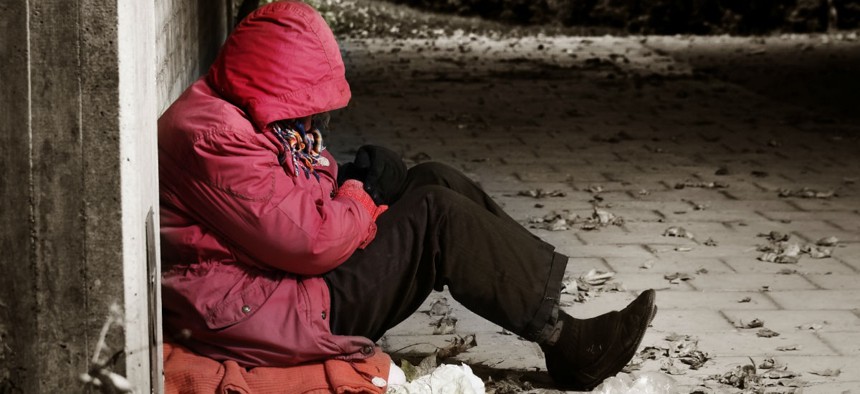
Mikael Damkier / Shutterstock.com
Homeless Shelters? HUD Is Working on Finding a Better Way
Housing vouchers aren't cheap, but they seem to be the best strategy for keeping a roof over everyone's head.
America has the largest number of homeless women and children in the industrialized world. It's a depressing statistic exacerbated by a housing crisis that forced thousands of families out onto the street. The stories of the 1.6 million children who experience homelessness every year—like that of Dasani, an 11-year-old homeless child profiled by The New York Times last year—are reminiscent of tales from developing countries or disaster zones.
In 2010, the Obama administration announced a plan to end homelessness among children, youth, and families by 2020—but, predictably, there have been spats over funding and how to best use federal dollars.
Now a rigorous report, the first large-scale experiment ever conducted to test the effectiveness of homelessness interventions for families, might have some clues about how to create meaningful change. It suggests that providing vouchers to the homeless so they can afford permanent, stable housing may be the most effective means of keeping a roof over their heads.
The Family Options Study is a three-year-long evaluation of three types of ways to help homeless families, conducted by the Department of Housing and Urban Development (HUD), Abt Associates, and Vanderbilt University. It looks at 12 communities in a variety of U.S. cities—including Boston, Denver, Kansas City, Phoenix, and Honolulu—and involves 2,300 homeless families. The findings so far—the study is currently at its midway point—suggest some solutions for reducing homelessness and improving the lives of low-income families, even those who are currently housed.
"This is an incredibly exciting study," said Kathy O'Regan, HUD's assistant secretary for policy development and research. "I think this is influencing the work we do immediately and in the future. You don't have that many studies where you say that early on."
The research is following families who were given different types of housing assistance. The first group received a Housing Choice Voucher (commonly known as Section 8), which provided participants with a subsidy for permanent housing. The second group was given temporary rental assistance for housing in the private market, an option known in the housing world as rapid rehousing. The third group received time-limited housing in a setting that included services like medical assistance and counseling. The fourth group received the usual type of interventions that a homeless family would be given, such as some time in emergency shelters and whatever housing assistance they can find on their own.
After 18 months, families using the Housing Choice Vouchers are doing much better than those who received traditional interventions. Children in the families that were given vouchers moved schools much less frequently than they otherwise would have. These families spent less time in shelters, the parents had fewer health problems and lower incidences of domestic violence, and they were more stable mentally than those who received typical interventions.
About one-quarter of the homeless families surveyed had spent at least one night in a homeless shelter in the past month; only about 10 percent of families using vouchers had. About 65 percent of homeless families in the usual-care group worried about food; only about 10 percent of families receiving a voucher did. And 4.6 percent of usual care homeless families said they were in fair or poor health; less than 1 percent of subsidy families said the same.
There was one negative aspect to giving families vouchers—household members became less likely to have a job. That's because, with housing covered, there's less need to work; also, voucher programs require families to pay one-third of their income toward rent, which means the net wages they keep are relatively small.
Housing vouchers may sound like an expensive way to prevent homelessness, but so far, the costs aren't actually that different than those of other programs. The average monthly cost of serving a family in an emergency shelter is $4,819 a month. Transitional housing costs about $2,706, rapid rehousing costs $878, and a permanent subsidy, or voucher, costs about $1,162. Of course, the permanent subsidy is the only program where these costs recur for more than a year or two, so the costs add up. But a housing subsidy isn't necessarily forever. Being in permanent housing can allow families to get back on their feet, find work, and get off subsidies, says Michelle Wood, who leads the study. Families often use subsidies for three or four years and then move on.
Housing Choice Vouchers are in high demand for many families across the country—not just those experiencing homelessness. The "sequestration" cuts in the federal budget eliminated 100,000 vouchers. And though the president's 2016 budget would reverse those cuts and add an additional 67,000 vouchers, still only about 5 million people in 2.1 million families receive the vouchers, and there's little political pressure to expand the program further.
But this study, which will release follow-up results after 18 more months, shows how important vouchers are for improving the well-being and outcomes of low-income families, said Jill Khadduri, a former HUD researcher who now works for Abt Associates, a research firm. This is the first hard evidence to show that housing stability can help kids stay in school and can also help families stay together.
"I certainly wish that political will existed to expand the program," she said. "Vouchers are an important part of the social safety net, and they really help people at the bottom of the income distribution, including people who are working."






